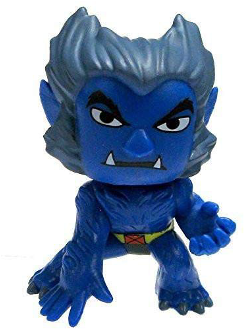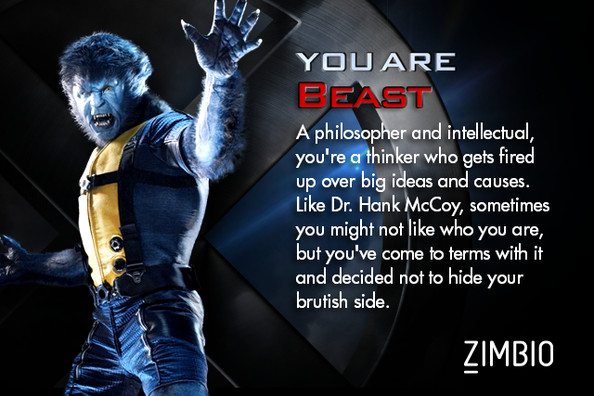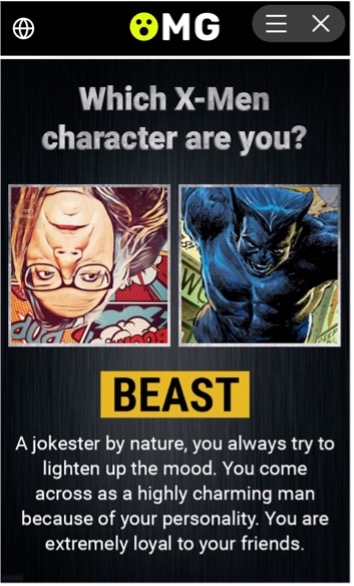How X-Men’s Beast is My Kindred Spirit, or How I Really Need to Reclaim Blue[1]
In the spring of 2017, I was enrolled in the second iteration of “HNR 360 (Dis)Abling Comic Books” at Syracuse University.[2] Midway through the semester, I sat down and began to work on a class assignment as well as creating the poster for “Our Own Icons! Cripping” the Comic Con 2017 (aka “CripCon”). Sitting in a coffee shop, I had brought with me several “Funko-Pop Mini Mystery X-Men Bobble Head” collectible figures previously purchased as inspiration. On that day, April 2nd, these boxed action figures were stacked in front of me, sealed tight, waiting for me to reveal their secrets.
After some reticence, I began to open them randomly. After receiving one Storm and doubles of Professor X, Logan/Wolverine, and Emma Frost, I found myself more than ready to open that one final box. With great hope, I opened it quickly, hoping to get another X-Men character that I hadn’t gotten before. To my profound joy, I got… Beast! Blue in all his fanged, furry glory. But my joy then became muted, only because I realized the day, and the month. April 2nd was not only World Autism Day, but also one of the first days of Autism Awareness Month,[3] when Autism Speaks wants us all to “Light it Up Blue” and my senses are assaulted all month long with any number of blue autism-related things.
So, perhaps I should explain my hesitation and consternation. Blue is a color I generally try to avoid in April, especially anything related to autism “awareness.” Since there are so few blue superheroes (and supervillains) to admire (or despise), I thought the situation incredibly ironic, to open this package on this particular day, at that moment, and have Beast emerge in all his blue animalistic awesomeness. As a result, I began to think more about this timing—and the color blue. Could this color ever be reclaimed by the Autistic[4] community?
Autism Speaks has been the prime progenitor of what many perceive as negative Autism representations, primarily from the perspective of many Autistics. This organization often shares stories, statistics, representations, and on and on that nearly all feature the color blue, deeply offending me and many others. I have many Autistic friends and colleagues who resist—and detest—the use of this particular color as well as this awful rhetoric. These advocates all work diligently to counter this nonsense all autism “awareness” month long (and beyond). I give them my full support—but I am also quite quiet during this month. I am reluctant to speak up, tell my story, any story about autism, not only as an ally to Autistic individuals and a Neurodivergent individual, but as a parent to an Autistic individual. Of course, when I do, I focus on “who is the expert” when the subject of autism is involved,[5] even as I now identify as Neurodivergent. Is my story an autism story to tell? Who has the right to tell stories around autism? Do I?
Around this time in 2017, there were many circumstances and situations where several things relevant to Autism Awareness Month unfolded in popular culture, whether they were previous representations, recent ones, or those under development. For example, the Blue Ranger in the Power Rangers reboot that year was revealed to be rewritten as a black autistic teenager (but a non-Autistic actor was cast). Was this choice deliberate or not? I can’t be certain. But perhaps more relevant, or tangential even, the famous actor William Shatner ranted on social media, expressing how he felt more bullied than educated on the subject of puzzle pieces and autism. The even greater irony is this man, known for portraying “Captain Kirk,” reacted with such blatant ableism; Kirk, the main character in the famous sci-fi TV show, Star Trek, the show featuring the logical and literal Mr. Spock that so many Autistic and Neurodivergent people might and do relate to—Mr. Spock, who, ironically, wears a blue Starfleet uniform. There’s blue, again.
Much of this was not a coincidence; at that time, I felt a shift around me and still feel it even now—as I try to hold onto my own worlding, my own multiverses. But in 2017, those things I had tried to cling to or gain sustenance from had been crumbling on all fronts. I faced—and continue to face—uncharted territory with aging, with parenting an Autistic child, with doubting my skill sets and more. But do I have a right to tell an autism story, any autism story? I might. This poignant moment in time is one such story I might share.
The purpose of stories, my story, too, particularly those that might make me and others quite uncomfortable, might be best put forth in a graphic narrative or something else more creative instead of one stagnant blog that I keep hidden from the world. Lydia X. Y. Brown (Autistic scholar and activist to boot) commented once[6] “what is the purpose of poetry [or any writing for that matter] that aims only to make those already privileged and powerful feel more comfortable?” Thus, I write and write and write, and continue to do so, so maybe I need to take a chance and make some people uncomfortable. I need to face the gulf of uncertainty (Who will read this? Who will it offend?) and take a huge leap.
Among this culture shift, the world that I adore, the domain I’ve always taken great joy in—comic books and all—was most definitely in turmoil at that point in time, too. Captain America was revealed as a secret Hydra agent since the beginning of his tenure; this ended with Cap [SPOILER ALERT] being mind-controlled by his nemesis, the supervillain, Red Skull. Magneto—a Jewish X-Men anti-hero who survived the Holocaust—also appeared to be allied with Hydra, an organization with Nazi connections, but ultimately there was a misunderstanding. Hidden anti-Christian, anti-Jew political messages appeared in certain panels of X-Men Gold #1, one of many comic series within the X-Verse, in an overall X-Verse narrative “that has explicitly addressed the question of how people can learn to live with difference.” And there were the headlines saying Marvel and others in the comics industry were blamed for dwindling sales, complaining about there was too much diversity in comic lineups, particularly focusing their blame on feminists and “Social Justice Warriors (SJWs)” a la “Comicsgate.”
So, I had plenty to consider. As a result of getting Beast—amongst all this Autism and pop culture controversy—I wondered, am I blue, myself? Or am I simply shady or moody? Perhaps. Anyways, I kept thinking—and still do—of living, telling, being, focusing on my own worlding in the Aut-Universe, in the X-Verse, and in the Disability/Crip Universe, and now I know that I could indeed channel—and admire—Beast, blue or not (I also considered the images, below).
If Beast can evolve and change (sometimes for good, sometimes for naught) and still be pro-mutant/pro-disability for the greater part of his story arc, despite his “blue hue,” why can’t we all? Why can’t I? I can, I might, but that day I decided that any one of Beast’s many visages could never be my profile picture, at least not until May 1st.



Notes:
[1]I acknowledge with respect the Onondaga Nation, Firekeepers of the Haudenosaunee, the Indigenous People on whose ancestral lands Syracuse University now stands and upon where this essay was written and edited.
[2]This essay is based on an assignment for HNR 360 and originally titled “Beast is my Spirit Animal, Or How I Really Need To Reclaim Blue.” The course was developed out of the “‘Cripping’ the Comic Con” symposium which previously took place annually, 2013–2017, then once more in 2019 at Syracuse University. The course was created, organized, and led by Prof. Diane R. Wiener, and co-created with my input. I subsequently was a guest lecturer in the class, presenting on the X-Men and Deadpool, among other relevant topics.
[3]Please understand that while some noted “Autism” organizations have decided to shift to designating April as “Autism Acceptance Month” this doesn’t necessarily mean their philosophies and strategies aren’t still blatantly “autistiphobic,” a term coined by Dr. Nick Walker in her book, Neuroqueer Heresies. Many Autistic-led organizations have designated April in this way, but for different reasons altogether. #ActuallyAutistic people have begun “flipping” the rhetoric, instead turning their focus on “allism” (read, for example, “Tone it Down Taupe” or #RedInstead); alternative, more Aut-positive ways to foster community and solidarity and promote autism acceptance, all done to contradict the use of the color blue by hate-based organizations like Autism $peaks.
[4]In some instances, I use identity-first language and/or Autistic (with a Capital A) or Neurodiverse/Neurodivergent (both with a Capital N), purposely. I acknowledge that not everyone identifies as Autistic or Neurodivergent, nor uses identity-first language.
[5]In Neuoqueer Heresies, Dr. Nick Walker explains this well: “Listen to Autistic people, and read what we write” (p. 161). She is not alone in making this assertion. Increasingly, Autistics are sharing their perspectives and expertise. See, for example, books, such as Loud Hands: Autistic People, Speaking or All the Weight of Our Dreams: On Living Racialized Autism, and as well as more academic resources, including “Whose Expertise Is It? Evidence for Autistic Adults as Critical Autism Experts”; Ought: The Journal of Autistic Culture (“Ought focuses contributions of the autistic community”) and Autism in Adulthood (“This innovative journal integrates the contributions of autistic adults—as Editorial Board members, authors, peer-reviewers, and readers—into the peer-reviewed literature.”). I could cite many more examples.
[6]Brown made this observation in a DS-HUM listserv exchange in April 2017, just one message in a thread responding to a request to share and celebrate disability poetry for National Poetry Month on April 1st. I’ve some added words of my own for emphasis.
[7]The Micro Mutant Postcard Project is “an ongoing endeavor seeking to meld poetry, confessions, memoir, and imagery with pop culture, especially comic books, and identity, including disability, using specific conventions to bring forth creativity and explore intersections the author has perhaps not yet publicly revealed.”
Read Rachael’s reviews of Disabled People Transforming Media Culture for a More Inclusive World and Season One: Iris and the Crew Tear Through Space!; two of their Micro Mutant Postcard poems; and the Gatherer’s Blog in this issue of Wordgathering.
Back to Top of Page | Back to Essays | Back to Volume 18, Issue 1 – Summer 2024
About the Author
Rachael A. Zubal-Ruggieri (she/her, they/their) is a long-time employee at Syracuse University. She is also co-creator (with Diane R. Wiener) of “Cripping” the Comic Con, the first of its kind interdisciplinary and international symposium on disability and popular culture, previously held at SU. At conferences and as a guest lecturer, she has for many years presented on the X-Men comic books, popular culture, and disability rights and identities from her perspective as Neurodivergent and as a Mad Queer Crip. Entries in their “Micro Mutant Postcard Project”[7] have been published in Wordgathering: A Journal of Disability Poetry and Literature and Stone of Madness Press. Their most recent publications include two articles authored with Diane R. Wiener in Volume 17, Issue 3 of the Journal of Literary & Cultural Disability Studies, in the Special Issue: Cripping Graphic Medicine I: Negotiating Empathy and the lived Experiences of Disability in and through Comics.